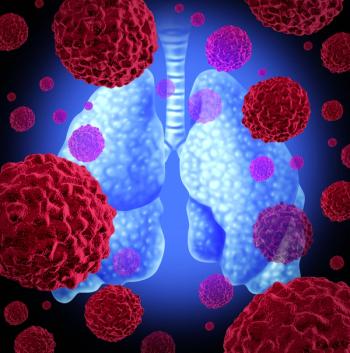
Findings Show Resistance Mechanisms in Small Cell Lung Cancer
A study, published in Nature Cancer, demonstrates the quick and evolving revolutions of resistance mechanisms in small cell lung cancer.
Recent study findings, published in Nature Cancer, unmasked the multiple resistance mechanisms in small cell lung cancer (SCLC) cells.
Researchers from The University of Texas MD Anderson Cancer Center in Houston, Texas, found that treatment resistance in SCLC may be characterized by coexisting subpopulations of cells with heterogeneous gene expression leading to multiple, concurrent resistance mechanisms, called intratumoral heterogeneity.
“Now, we understand better what this looks like and that we need to be able to do two things. One is that we need to bring our most effective new treatments that are being developed as early as possible into the treatment with the goal of trying to prevent the cancer from evolving and adapting,” Lauren Averett Byers, MD, associate professor of thoracic/head and neck medical oncology at MD Anderson, said in an interview with CancerNetwork.
“The other thing is that we are also looking at the future,” she added. “One of the things we want to do is look at whether there are ways to prevent the cancer from being able to evolve and adapt and what's letting (the small cell lung cancer to) become resistant to treatment. And so, there may be ways to prevent it from turning on new signals that help it to escape treatment.”
SCLC, which is a disease that has had few therapeutic advances in the past 30 years, according to Byers, accounts for 14% of all lung cancers and is often rapidly resistant to chemotherapy. Five-year survival is less than 7% across all stages, but there is no highly effective second-line therapies when the tumor recurs.
“One of the major challenges that we face in treating small cell lung cancer is that most patients initially respond very well to chemotherapy…which is essentially all cisplatin- or carboplatin-based treatment, and we get these really good responses initially, but then often, in a very short period of time, the cancer becomes resistant to the treatment and it starts to grow again,” Byers explained. “In many patients, when that happens, we try other types of treatments like other types of chemotherapy or approved immunotherapies, but most patients don't respond to therapy.”
Because of the disease’s aggressive nature, the disease can grow quickly when it recurs. Therefore, biopsy samples can be hard to acquire.
“And if patients do have a biopsy, the biopsies tend to be very small samples,” Byers said. “So, we've had this real challenging situation where we (don’t have enough biopsy samples of small cell lung cancer that has relapsed) after previous chemotherapy in order to try to study why this was happening or what was contributing to it.”
The researchers developed novel disease models by isolating circulating tumor cells (CTCs) from a simple blood draw. They then performed single-cell RNA sequencing on 14 CDX models to identify gene expression differences between individual cells from chemotherapy-sensitive CDX tumors compared to those that remain resistant.
In addition, they also performed single-cell sequencing directly on circulating tumor cells retrieved from one patient before treatment, during treatment and after relapse.
“Our main finding was that small cell lung cancer that was more resistant to chemotherapy were much more complex. If you looked at the individual cells that were making up these tumors, we saw that there were different populations of cancer cells within the same tumor, and one group of cells might have one type of resistance and another group of cells might have another type of resistance.”
Moving forward, the researchers hope these findings can bring novel treatments to the forefront of SCLC therapy. In addition, they want to understand if there are changes that happen also in the immune cells.
“We want to understand if there ways to improve upon the current available therapies or if there are ways to enhance their effect. Again, it is the idea of trying to get our most effective treatments to patients with small cell lung cancer as early as possible,” Byers said.
“These findings emphasize the need for clinical efforts to focus on rational combination therapies for treatment-naïve SCLC tumors to maximize initial responses and counteract the emergence of (intratumoral heterogeneity) and diverse resistance mechanisms,” the researchers wrote.
Reference:
Stewart CA, Gay CM, Xi , et al. Single-cell analyses reveal increased intratumoral heterogeneity after the onset of therapy resistance in small-cell lung cancer. Nature Cancer. 2020; doi:10.1038/s43018-019-0020-z.
Newsletter
Stay up to date on recent advances in the multidisciplinary approach to cancer.
































































































